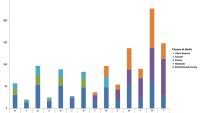GRAPH

Charting a Course to Health
Heart disease, cancer, and other chronic diseases are on the rise, and with them the cost of medical care, which may run into the millions, even for a single individual; for an entire population, the financial and social burdens of disease are vast. In the face of this reality, communities and organizations are increasingly investing in preventive health interventions, from bicycle lanes to smoking cessation programs. While prevention is understood to be substantially more cost-effective than paying for the consequences of poor health, there is a frustrating lack of information about the return on investment for prevention—both in strict cost-accounting terms and in improved quality of life.
Since 2013, the Global Research Analytics for Population Health program, better known by the acronym GRAPH, has worked to fill this gap. Mailman School faculty, led by Peter Muennig, associate professor of Health Policy and Management, are uncovering new ways to quantify the effectiveness of prevention programs and to identify emerging priorities. The team has met with Fortune 500 executives, heads of state agencies, and philanthropic organizations to help answer questions like what is the return on investment for a company’s employee wellness program. Currently, GRAPH is working with NewYork-Presbyterian Hospital leaders as they adhere to the Affordable Care Act requirement that they be responsible not only to their patients but also to the communities where they live. Mailman School scientists are conducting a “community diagnosis” of our Washington Heights neighborhood by mapping the area’s disease burdens alongside health resources such as primary care clinics, health screenings, and the availability of nutritious foods. At the completion of the project, NewYork-Presbyterian will have a menu of cost-effective options to promote health and reduce hospitalizations. The researchers anticipate that this approach can be applied in other locales.
On the global front, GRAPH researchers are undertaking an ambitious, two-year, Rockefeller Foundation-supported project to assess the full public health armamentarium of preventive interventions. They will analyze the research literature to understand the relative merits and costs of, for example, peer education for sex workers or a comprehensive ban on alcohol-related advertising. Building on GRAPH’s research in prevention science, GRAPH scientists will give countries interventions attuned to their population’s unique health needs.
“GRAPH is part of a large agenda to make the case that the U.S. healthcare system and those around the world are far too focused on medical interventions and curative care at the expense of population-based prevention,” says Michael Sparer, chair of Health Policy and Management and one of GRAPH’s creators.